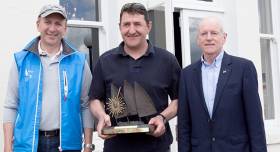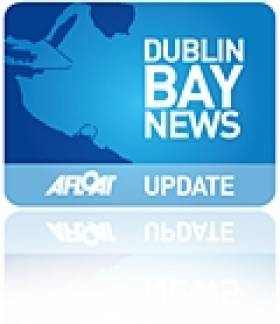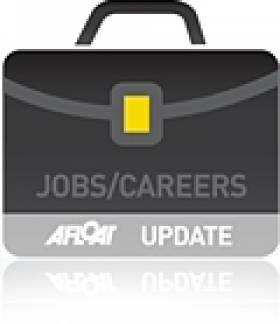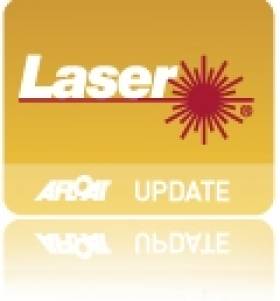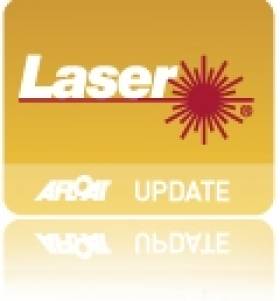Displaying items by tag: MASTER
Royal Cork's Nick Walsh was the winner of the Irish Laser Master Championships at the National Yacht Club at the weekend. The Crosshaven man beat local Dublin Bay Sailing Club's Dan O'Connell on the tie break rule after both sailors finished on the same nett points of 14 after six races sailed. In third place in a 26–boat fleet was Royal St. George Yacht Club helmsman Sean Craig on 19 points. Paul Ebrill of Wexford Harbour Boat Club was the winner of a five boat Radial fleet. Results are downloadable below.
This popular event, open to Lasers Sailors aged 35 and over, is now in it's 10th year and firmly positioned as an annual favourite with the class members.
This year the fleet was bouyed by many new faces and a fledgling radial fleet both of which are very positive future signs.
Cork as usual sent a strong contingent, Wexford too was represented, Galway provided some of the new faces and Ballyholme sent a boutique but talented squadron of challengers. From closer to home it was great to see support from Howth YC. The RStG really padded out the numbers with a large showing and local boats also launched from the RIYC, DMYC and Coal Harbour for a total of 35 racing.
Ron Hutchieson was, as usual, officiating shoreside ably assisted at registration by Sandra Moore.
On day 1 a brisk SW'ly met the sailors as they ventured out towards Seapoint. It was looking a lot like a tough day on the bay. Before Race 1 got underway the breeze had moderated a little but the course was still being raked by strong gusts. Choosing which side of the bay to aim for was going to be crucial.
The fleet was very eager to get away and there were two general recalls before PRO Con Murphy unleashed the fleet and let them at it. The inner loop trapezoid course is very popular with the Laser sailors as it provides a good W/L course complete with 2 and a quarter beats alongside a sprinkling of blast reaches thrown in for good measure.
In race 1 Nick Walsh laid down a marker to take the bullet and begin his quest to reclaim the title he lost to Roger O'Gorman in Ballyholme 2015. Nick wasn't having it all his own way and it was a hard fought race with big wind pressure changes and shifts. 'Head out of the boat' was the order of the day. Second was Dan O'Connell and Paul Keane opened his account with a 3rd.
In race 2, David Hillmyer visiting from Sarasota Sailing Squadron in Florida showed great mental reserve to hold his lead to the finish from the marauding pack who were chasing him down after the breeze shut off. Sean Craig scored a handy 2nd while Daragh Sheridan bagged the last podium place. Front runners Dan O'Connell and Nick Walsh had a 6th and 7th respectively.
Race 3 (part #1) was going all the way of Ross O'Leary and Shirley Gilmore in a radial who were launched on the paying side of a huge shift before Con, cruelly perhaps but demonstrating why he is so respected as a PRO, abandoned the race to reset the course. The wind had other ideas and disappeared completely so Con weighed anchor to head into the bay in search of some new pressure. Summer turned into an Autumn gale as a strong line squall found the fleet. When the squall abated Con was able to reset a course and the fleet was quickly off again.
Race 3 (part #2) went to Nick Walsh to put him in the overnight lead. Dan O'Connell was 2nd and Robert Howe began to find his form with a third. Points wise it was very close at the top and a good indicator of things to come.
Saturdays Master Class dinner in the National YC was a perfectly tempered meal. Tired sailors caught up over a delicious meal provided by Louise and her A-Team of helpers.
Sunday morning dawned bright and sunny with a mysterious, light, but very raceable westerly breeze in place of the pessimistic soft forecast. The breeze held nicely for the first race though it was hard going keeping the concentration on the beats and torturous body positions downwind.
Sean Craig revels in the light air and the more twisted the turns in conditions the better. In Race 4 he stamped his mark, and his larger intentions, on the fleet with a convincing win. With Dan again in 2nd and Nick bagging a 3rd the leaderboard was getting tighter and tighter at the top.
Race 5 went to Rob Howe who was on a bit of a charge as he tried to negate a heavy DNF from Saturdays racing. Ross O'Leary popped up in 2nd and Nick posted a 3rd against Dan's 11th.
After race 5 the wind abrubtly but simply shut off! Con, with his usual instinct for detection of the slightest zephyr, upped sticks and set off into the bay in search of breeze. He really should play the lottery as a perfect sea breeze duly arrived as if by magic from 155deg.
His very experienced mark laying team led by Dave Morley were quick to take advantage of the cards they had been dealt and set up a course in record time. And so Race 6 was quickly underway in a sunny glamour 12-14kts, perfect champagne sailing (with a little lightning and thunder across the bay) for the fleets last hurrah.
At the first mark it was neck and neck between O'Connell, Craig, Rice and Keane who all rounded in unison. It was Keane who got a lucky break and the inside berth on the downwind to lead at the bottom. He held the lead for the remainder of the race and despite a strong challenge by O'Connell on the finish line took the bullet. Rob Howe finished in 3rd with Craig in 5th and Nick back in 6th.
As the sailors headed towards the harbour the conversation on the water turned to maths. Incredibly Nick and Dan were tied for 1st on 14 points and 3rd place was a tie three ways between Sean Craig, Rob Howe and Paul Keane on 19. The top slot in the radial too was a tie between Paul Ebrill and Shirley Gilmore.
Ron applied the various countbacks as dictated by the SI's and the leaderboard took on it's final shape. Nick Walsh is again Masters Champion and Paul Ebrill Champion in the radials. The complete and official results can be viewed below
Dun Laoghaire's new Harbour master is Captain Frank Allen, according to an announcement by Dun Laoghaire Harbour Company this morning.
Captain Allen replaces Captain Simon Coate who is retiring.
A native of Cork, Captain Allen has spent all his working life in shipping. His first management role was as General Manager of Dundlak shipowners from 1986 to 1997. He was then appointed Ships captain for Carrisbrooke Shipping in the UK and subsequently worked as Operations Manager for Swansea Cork Ferries from 199 to 2003 before joining Dundalk Port as Harbour Master.
The Harbour Company is about to launch a Masterplan for the 200 year old harbour., the country's largest sailing and boating centre.
Dun Laoghaire Seeks New Harbour Master
Greagsbey in Front at Howth Laser Frostbtes
McMahon and Hegarty Win HYC Laser Races
HOWTH YACHT CLUB. LASER FROSTBITE WINTER 07/11/2010 RACE 1 LASER STANDARD: 1, Paul McMahon HYC; 2, Conor Greagsbey NYC; 3, Darrell Reamsbottom HYC; 4, Conor Murphy HYC; 5, Daragh Kelleher SSC; 6, Stephen Quinn HYC; LASER STANDARD APPRENTICE: 1, Conor Murphy HYC; 2, Brendan Costello MYC; 3, Brian Tyrrell HYC; 4, Conor Hopkins HYC; LASER STANDARD MASTER: 1, Paul McMahon HYC; 2, Conor Greagsbey NYC; 3, Darrell Reamsbottom HYC; 4, Daragh Kelleher SSC; 5, David Quinn HYC; 6, Evan Dolan NYC; LASER STANDARD GRAND MASTER: 1, Stephen Quinn HYC; 2, Robin Hegarty HYC; 3, Daragh Sheridan HYC; 4, Cathal Sheridan MYC; 5, Dermot Mowatt HYC; 6, Alan Carr SDC; LASER RADIAL: 1, Darragh Peelo MYC; 2, Vincent Varley MYC; 3, Robert Ferris HYC; 4, Simon Revill HYC; 5, Ciaran Costello MYC; 6, Carla Fagan
HYC LASER FROSTBITE WINTER 07/11/2010 RACE 2 LASER STANDARD: 1, Robin Hegarty HYC; 2, Colm Cunningham HYC; 3, Conor Greagsbey NYC; 4, Paul McMahon HYC; 5, Conor Murphy HYC; 6, Stephen Quinn HYC; LASER STANDARD APPRENTICE: 1, Conor Murphy HYC; 2, Conor Hopkins HYC; 3, Brendan Costello MYC; 4, Brian Tyrrell HYC; LASER STANDARD MASTER: 1, Colm Cunningham HYC; 2, Conor Greagsbey NYC; 3, Paul McMahon HYC; 4, Darrell Reamsbottom HYC; 5, Richard Deane HYC; 6, Evan Dolan NYC; LASER STANDARD GRAND MASTER: 1, Robin Hegarty HYC; 2, Stephen Quinn HYC; 3, Dermot Mowatt HYC; 4, Conor Costello MYC; 5, Daragh Sheridan HYC; 6, Edward Ferris HYC


























